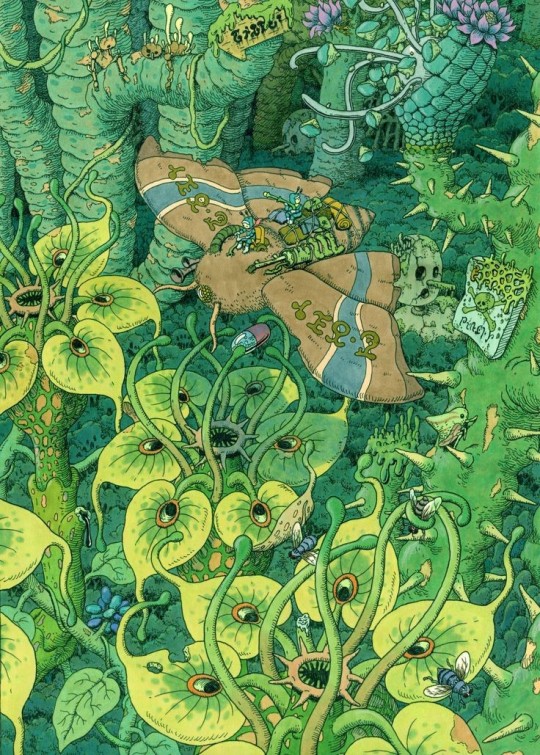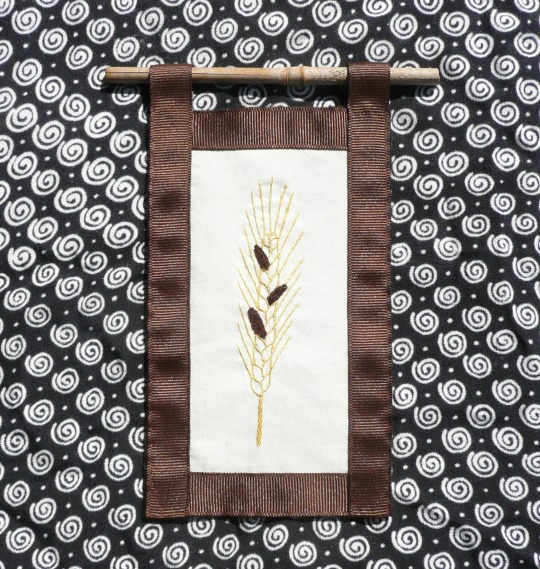#Plant Pathology
Explore tagged Tumblr posts
Text
COPING BY THINKING STUDYING FOR MY PLANT PATHOLOGY PAPER IS ACTUALLY VERY SOLAR PUNK CODED






#solar punk#solar punk aesthetics#solarpunk#solarpunk aesthetic#green#sustainability#art#aesthetic#exam#plants#plant pathology#paper#exams
612 notes
·
View notes
Text





My favourite gallery collection that I would absolutely kill to see is the Glass Flowers exhibit at the Harvard Museum of Natural History with pieces made by Leopold and Rudolph Blaschka in the late 1800's to early 1900's. In particular, it not only contains hundreds of fully accurate glass plant and flower models, but it also contains depictions of various plant diseases, fungi, and fungal spores! As a plant pathologist it's incredible how accurate and gorgeous these pieces are and I am in awe. I've seen folks post the sea creatures and the flowers themselves made by the Blaschkas, but I think it's important to highlight these incredible specimens as well. Hosts and diseases are attached in the alt text.
#glass work#glass art#plant disease#fruit#plants#disease#pathology#plant pathology#art glass#museum#exhibit#fruits#fungi#fungal disease
29 notes
·
View notes
Text

Plant Immune System Part 3
The plant immune system is the topic of my PhD thesis, which I'm currently writing following several years of lab-based research as a PhD student at Imperial College London under the supervision of Professor Colin Turnbull.
Here's an introduction to my research, which focused on how certain plants defend themselves against aphids.
Aphids are an important insect pest that threaten agriculture worldwide. As we learned in the previous post, plant resistance (R) genes control resistance to specific pests and pathogens through interaction with effectors from the invaders. Since examples of R gene-dependent aphid resistance have been documented in different plant species, aphid-specific R genes may enable the development of resistant crops.
In the model plant Medicago truncatula, there are some varieties that are resistant to aphids and other varieties that are susceptible to Pea Aphids (Acyrthosiphon pisum). Whether the plant is resistant also depends on the variety of aphid. In my project, the A17 plant is resistant to PS01 aphids but not to N116 aphids, while the DZA plant is susceptible to both aphid varieties.
What is the key difference in the resistant versus susceptible plants? Resistant A17 plants have a portion of their genome “Resistance to Acyrthosiphon pisum 1” (RAP1) which determines resistance to PS01 aphids, but the genes controlling the defence response and physiological defence mechanisms remain unknown. Two candidate R genes located in RAP1, designated “RAP1A” and “RAP1B”, may control resistance.
My main objective in my PhD project has been to determine whether RAP1A and RAP1B control aphid resistance, and to investigate the RAP1-mediated defence response. I look forward to sharing the findings in publications and in talks next year!
Image credit: Original diagram by Katia Hougaard with images from the Turnbull Lab.
#katia_plantscientist#science#biology#research#plants#botany#plantbiology#phdproject#plantbiology#plantscience#sciencecommunication#diagrams#phd#imperialcollegelondon#phdthesis#medicago#aphid#plantimmunesystem#pestsandpathogens#plantpathology#womeninscience#plantbiologist
#katia plant scientist#botany#plant biology#plants#plant science#diagram#science communication#science#sciencecore#plant scientist#biology#biologist#phdblr#phd life#phdjourney#phd student#phd research#gradblr#stem#immune system#cell biology#molecular biology#genetics#aphid#medicago#clover#plant pathology#my work
20 notes
·
View notes
Text


cercospora leafspot of hydrangea (Cercospora hydrangeae) on an oakleaf hydrangea (Hydrangea quercifolia)
2 notes
·
View notes
Text

Ergot-infected rye, 2023.
36 notes
·
View notes
Note
If you have one that’s not too identifiable, may I ask for one of your favorite plant fun facts?
I'll give you two general plant pathology fun facts. When faced with a biotrophic pathogen (one that invades and consumes living cells, though some do this for hemibiotrophic pathogens too) the plant may trigger a kind of localised defensive cell death called a Hypersensitive Response (HR). It acts a bit like a biological fire break, creating a region the pathogen cannot progress too far into, and halting much more extensive damage.
Another one! Plants can have their whole-body immune response primed in advance, meaning that when the pathogen does come around, the plant might have a better chance fighting it. There's at least two forms of this, each playing with different signalling hormones: Systematic Acquired Resistance (SAR) with the Salicylic Acid pathways, and Induced Systematic Resistance (ISR) with the Jasmonate and Ethylene pathways. But they can be primed by things other than pathogens: benign soil bacteria is a common one, especially for ISR.
#not podcast related#:D#These might be kinda basic but I do think they're neat#Edit: Not basic! I am like the stickpeople in the XKCD comic.#plantblr#plant pathology
12 notes
·
View notes
Text
so much smut
there's covered smut, loose smut, stinking smut, corn smut, onion smut
smut smut smut
2 notes
·
View notes
Text
Science is all about the accidental discoveries, yo.
scientists in the 1990s, putting a Get More Purple gene attached to a harmless plant virus into an already purple petunia: please get more purple
the petunia, sensing an apparent honest to god Get More Purple Disease, using the previously undiscovered RNAi antiviral ability to shut down all other purple genes along with it just in case: you put VIRUS in petunia? you infect her with the More Purple?? oh! oh! her children shall bloom white! jail for mother, jail for mother for One Thousand Years!!!!
251K notes
·
View notes
Text

The Science Research Diaries of S. Sunkavally, p 586.
#manuscript#cursive handwriting#diaries#Hawaii#Drosophila#plant pathology#leukocytes#retinal blood flow#resting membrane potential#beauty#compassion#women#maize production#influenza#acid lakes of Sweden
1 note
·
View note
Note
Hopefully future plant pathologist here :) I wanted to ask if you think that there is room in the conservation-focused area of botany for plant pathologists currently? Also what made you want to study this subject!
Hey! Absolutely there is, especially in the area of forestry and forest health in general! Combatting stuff like white pine blister rust and beech bark disease are the first things that come to mind. There's other things like chestnut blight where people are working on maintaining and reintroducing trees resistant to the disease. There's absolutely other stuff but these are some of the first things that come to mind! There also a lot of plants that are preserved for their importance in medicine and indigenous culture that develop issues with disease when we try to grow them in tissue culture or rear them in greenhouse.
As for what made me wanna go into this, I've always liked plants and I knew I wanted to study botany in grade 10, but once I reached the second year of my undergrad in plant science I took a course that involved plant health and the environment. That course introduced me to plant pathology and I found out it was everything I loved learning about in one field! I loved insects, fungi, bacteria, and plants, and I had an interest in the disease side of human medicine, so it was crazy that there was a plant equivalent of that!
7 notes
·
View notes
Text
youtube
A big thank you to everyone who attended my first live and in person science talk of 2025! It was a pleasure sharing insights on the plant immune system combined with practical eco-friendly pest control tips at the historic Church of Saint Peter and Saint Paul's in the village of Broadwell near Lechlade. My gratitude to Anne and Phil Taylor, Annabel Molyneaux, and the rest of the support team who took care of the excellent AV set up and delicious afternoon tea. More talks are in development for this year!
PS. I'm aware of the irony of having a science lecture in a church!
Music by Derek and Brandon Fiechter #science #sciencecommunication #publicspeaking #sciencetalk #plantscience #plantpathology #plantbiology #botany #plantimmunesystem #localevents #community #scicomm #plants #biology #plantbiology #historicbuilding #cotswoldschurch #mediaeval
#science#science communication#science communicator#public science lecture#plant science#plant pathology#plant biology#plants#katia plant scientist#plant scientist#biology#public speaking#science talk#cotswolds#church#mediaeval architecture#Youtube
6 notes
·
View notes
Text
Comparative Analysis of Blights: Early Blight, Late Blight, and Gummy Stem Blight
In the field of plant pathology, the ability to differentiate between different diseases is essential for efficient crop management. This article examines the traits that differentiate Early Blight, Late Blight, and Gummy Stem Blight. Early Blight Early Blight, caused by the fungus Alternaria solani, is a common disease that affects a wide range of plants, particularly those in the Solanaceae…

View On WordPress
#Agricultural challenges#Agricultural Environment#Agricultural Landscape#Blights#Comparative Analysis#Concentric Ring Pattern#Crop Health#Crop Losses#Crop management#Crop Protection.#Diagnostic Traits#Disease Characteristics#Disease Differentiation#Early Blight#Growers#Gummy Stem Blight#Intervention Strategies#Late Blight#Lesions#Plant Pathology#Prompt Response#Resilient Farming#Timely Identification#V-Shaped Blight Pattern#Visual Indication#Water-Soaked Appearance
0 notes
Text

Yarrow and Feverfew
Art trade with the incredible @liscepu, I'm so grateful for the chance! Thank you for fueling my love for the game again <3
#arthur morgan#red dead redemption#rdr2#rdr fanart#flowers#portrait#illustration#Also#since gathering and crafting from plants is one of my fav things in open world games I've been really enjoying drawing game characters with#like I've done with Geralt or Pathologic before - I will be definitely doing that more in the future! <3#This also reminded me I still need to return to platinum-ing RDR2...#...These damn 70 golden medals tho#I have no idea how I'll do it 💀
8K notes
·
View notes
Text

tensile tectonic friction of chorus, of adyton
#pathologic#pathologic 2#aglaya lilich#herb brides#my art#this would be my portfolio tag if i had a portfolio [portfolio tag]#ata fanart technically 😗 technically the mullein & mulberries and thistle brides don't have a like. ''canon'' appearance i don't want them#to have one in **others'** minds i just wanted to indulge in some charadesigning based on plants. smiles.
610 notes
·
View notes
Text

Artemy Burakh
i haven’t drawn a piece that big in like . forever lol that’s how much this guy motivates me!! i’m watching a let’s play of P2 and i’ve seen a little more than half of it now, and i’ve been thinking about it like everyday …… like i expected to like it but not that much lol. i’m considering buying the game now 💭 but i think ill wait until im done watching both games. anyway yeah artemy bc i love him even tho he’s a struggle for me to draw. had trouble with his hair especially in this piece. woe is me for liking a realistic guy instead of my usual anime boys!
also hesitated between a few words for what to write. in the end i chose emshen idk if its the most fitting but 🤷 i’m new here!! anyway rly happy with this :]
#my art#pathologic#pathologic artemy#artemy burakh#pathologic fanart#мор утопия#im never drawing plants again tho this was SUCH A PAIN#only HATE kept me going#never having composition ideas again im back to drawing 3/4 angle faces on a white bg#this may be too dark also sorry…… got tired of tweaking it…..#its lore accurate this game is dark……#turn your brightness 🆙🆙
249 notes
·
View notes
